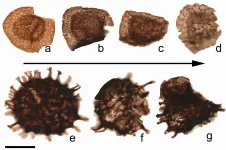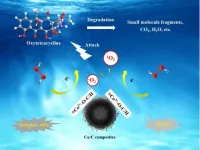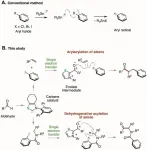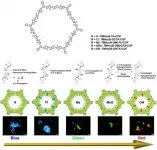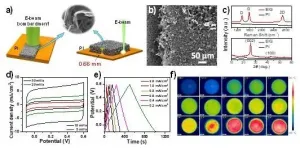Counting sheep and still awake? Mindfulness therapy may help bring on the zzz's
Researchers from the Centre for Sleep and Cognition at the NUS Yong Loo Lin School of Medicine found mindfulness-based therapy to be more effective than an active sleep hygiene programme in improving sleep quality
2021-07-06
(Press-News.org) Sleep problems are common in the general population with up to half of Singaporean adults reporting insufficient or unsatisfying sleep. Sleep quality tends to worsen with age and poor sleep is a modifiable risk factor for multiple disorders, including cardiovascular disease and cognitive impairment.
Currently, insomnia is treated with either medication or psychological interventions. However, even frontline treatments such as cognitive-behavioural therapy have limitations - up to 40% of patients do not get relief from their insomnia symptoms after undergoing this treatment. Furthermore, in Singapore, the waiting time to receive such treatment is long, as it is typically delivered as individual therapy and there are limited available local providers.
To search for alternative approaches to treat insomnia, Principal Investigator Assistant Professor Julian Lim from the Centre for Sleep and Cognition at the National University of Singapore's (NUS) Yong Loo Lin School of Medicine, together with the Singapore General Hospital's Department of Psychology, looked towards mindfulness-based treatment. Mindfulness is the awareness of moment-to-moment thoughts, feelings, and bodily sensations, and the practice of accepting these experiences without judging or reacting to them. Backed by scientific evidence, practicing mindfulness is becoming increasingly popular as a means to reduce stress, treat mental health problems, and improve general well-being.
The randomised controlled study compared a Mindfulness-Based Therapy for Insomnia (MBTI) with an active Sleep Hygiene, Education, and Exercise Programme (SHEEP) to see if the former could improve sleep outcomes in older adults with sleep complaints. A total of 127 participants, aged 50-80, were randomised and allocated between the two programmes - 65 received MBTI while 62 went through SHEEP. Both interventions consisted of eight weekly sessions which were of two hours duration each.
The MBTI course included formal mindfulness exercises such as mindful eating, sitting meditation, mindful movement and body scans. This was followed by a group discussion of their experiences during the past week, as well as the application of practices and principles of mindfulness which directly addressed their sleep difficulties. In addition, participants were taught good sleep habits and behavioural strategies that they could use to improve their sleep.
On the other hand, the SHEEP course provided participants with information about sleep biology, self-monitoring of sleep behavior and taught changes to make in their habits and environment that could improve sleep quality. Participants also learned and practised sleep-promoting exercises such as diaphragmatic breathing, morning and evening stretching movements, and progressive muscle relaxation.
Although sleep quality improved across the board, the study found MBTI to be more effective in reducing insomnia symptoms than SHEEP. Additionally, MBTI led to observable improvements when sleep was measured objectively - using wrist-worn activity monitors, and by recording electrical brain activity while participants slept at home. These objective measurements showed that MBTI participants took less time to fall asleep, and spent less time awake during the night, while this was not seen among SHEEP participants.
Explaining the study's findings, Assistant Professor Julian Lim said: "Insomnia is strongly linked to hyperarousal, or a failure to switch off the "fight-or-flight" system when it's time to sleep. It typically starts because of a triggering stressful event, and persists because some individuals go on to develop bad sleep habits and dysfunctional thoughts about sleep. MBTI uses behavioural strategies to address the bad sleep habits directly, such as encouraging people to get out of bed if they have difficulty sleeping to rebuild the association between the bed and good sleep, and mindfulness techniques to equip people with more flexible strategies to deal with the dysfunctional or arousing thoughts."
Assistant Professor Lim added, "The demonstration of the Mindfulness-Based Therapy as a viable treatment for insomnia presents possible valid alternatives for people who have failed or have no access to standard frontline therapies. Such treatment can be delivered in groups within and outside of a medical setting, providing members of the public with sleep issues easier and more efficient access to seek help."
INFORMATION:
The study has been reported in the journal Psychological Medicine on 1 July 2021, and was funded by the Singapore Millennium Foundation, the Far East Organization, and start-up funding from Duke-NUS Medical School and NUS.
The Centre for Sleep and Cognition at the NUS Yong Loo Lin School of Medicine studies the scientific underpinnings of human behavior and ways to improve sleep. Through research and advocacy efforts, the Centre seeks to enhance human cognitive potential as well as to reduce the impact of lifestyle factors and neurodegenerative diseases on cognition and well-being.
ELSE PRESS RELEASES FROM THIS DATE:
2021-07-06
In 2016, researchers from the EDDyLab - Evolution & Diversity Dynamics Lab - at the University of Liège (Belgium) proposed a new definition of the geological boundary between the Devonian and Carboniferous periods (359 million years). This new definition has been tested by hundreds of researchers around the world and the results are now compiled in a special issue of the journal Palaeodiversity & Palaeoenvironments.
Geological time is divided into periods (Cambrian, Carboniferous, Jurassic, etc.), together covering the 4.6 billion year history of the Earth. The many climatic, environmental and biological changes that have punctuated this history are recorded in the rock layers, forming an incredibly rich archive of the Earth's past. "The study of these successive ...
2021-07-06
Scientists from Tohoku University and the University of Maryland have pinpointed the strong magnetic field of the early sun as the reason behind the radial variation of rock and metal in rocky planets' cores. This magnetic field, which pulled small iron grains inward, explains Mercury's big iron core and why Mars has so little iron in its core.
The details of their research were published in the journal Progress in Earth and Planetary Science on July 5, 2021.
Planets have iron cores surrounded by a rocky shell, mostly made up of mantle and a thin skin of crust. The four inner planets of our Solar System, Mercury, Venus, Earth, and Mars have their own distinctive size and density. These ...
2021-07-06
Recently, a research team led by Prof. KONG Lingtao at the Hefei Institutes of Physical Science (HFIPS) of the Chinese Academy of Sciences (CAS) has prepared a type of hollow amorphous Co/C composites to activate hydrogen peroxide (H2O2) to generate singlet oxygen, achieving selective elimination of oxytetracycline (OTC) in complicated water matrices. The relevant results was published in Chemical Engineering Journal.
OTC is the most common tetracycline antibiotic in the field of animal husbandry. It can be detected in water, soil and other areas which features ...
2021-07-06
The study is the first on epidemiology and causes of traumatic brain injury in over 20 years. The research team reports in the journal BMJ Open of 4 June 2021.
Falling and cycling without a helmet are common causes
From a minor fall on a bicycle to a serious road traffic accident: The causes of a traumatic brain injury are manifold. About 90 percent of the approximately 270,000 cases per year are classified as mild, ten percent as moderate or severe. Current findings show that traumatic brain injury is increasing in the age group of over-65s. The research team at BG Kliniken in Bochum, Hamburg, Berlin, Halle, Frankfurt, Ludwigshafen and Murnau found that there has been a shift in the age group most frequently affected and ...
2021-07-06
[Background]
Aryl halides*1) with a benzene ring directly bonded to a halogen atom are readily available and chemically stable, so they are used as a source of benzene rings in organic synthesis. For example, a chemical reaction that generates a highly reactive aryl radical*2) from an aryl halide using a toxic tin compound has long been known as a method for supplying a benzene ring (Figure 1A). In recent years, chemical reactions have been developed, in which an aryl halide is reduced using a metal catalyst or a photocatalyst*3) followed by cleavage of the bond between the benzene ring and the halogen atom to generate ...
2021-07-06
Together with their multifaceted action mechanisms, activation-induced cytidine deaminase (AID) and so-called APOBEC proteins are important factors in the body's immune response and offer fast and effective protection against a large number of DNA and RNA viruses. The task of AID is to strengthen the human immune response, while APOBECs are able to block the virus. A MedUni Vienna research team comprising Anastasia Meshcheryakova, Diana Mechtcheriakova and Peter Pietschmann from the Institute of Pathophysiology and Allergy Research has now addressed the potential interrelations between AID/APOBECs and the SARS-CoV-2 virus, ...
2021-07-06
Ishikawa, Japan - Many researchers in the field of materials science constantly seek novel and versatile platforms that can be used to tailor materials to match their intended use. One example of this are covalent organic frameworks (COFs), an emerging class of crystalline porous polymers with a favorable set of fundamental properties, namely crystallinity, stability, and porosity. This combination makes them, in theory, adjustable to many modern applications. Unfortunately, owing to the way COFs are usually obtained, these properties are not very pronounced, resulting in unstable, low-crystallinity solids with limited porosity.
At the Japan Advanced Institute of ...
2021-07-06
Recently, Prof. WANG Zhenyang's research group from the Hefei Institutes of Physical Science (HFIPS) of the Chinese Academy of Sciences (CAS) has prepared macroscopic thick three-dimensional (3D) porous graphene films.
Using high-energy electron beam as the energy source and taking advantages of high kinetic energy and low reflection characteristics of e-beam, the researchers directly induced polyimide precursor into a 3D porous graphene crystal film with a thickness of up to 0.66 mm. Related research results were published in the journal Carbon.
Graphene has been proved ...
2021-07-06
A new nanotechnology development by an international research team led by Tel Aviv University researchers will make it possible to generate electric currents and voltage within the human body through the activation of various organs (mechanical force). The researchers explain that the development involves a new and very strong biological material, similar to collagen, which is non-toxic and causes no harm to the body's tissues. The researchers believe that this new nanotechnology has many potential applications in medicine, including harvesting clean energy to operate devices implanted ...
2021-07-06
Recently, with the help of a steady-state strong magnetic field experimental device, scientists constructed nano-scale borate bioactive glass (Nano-HCA@BG), which can effectively reduce the biological toxicity of borate bioglass, improve the biocompatibility of the glass, and promote the effect of borate bioglass on skin repair.
Prof. WANG Junfeng from the Hefei Institutes of Physical Science (HFIPS) of the Chinese Academy of Sciences (CAS), collaborating with Prof. ZHANG Teng from Fuzhou University in this study, said, "it is expected to become the next generation of skin wound repair dressings." Related research was published in Chemical Engineering Journal.
Borate bioglass is a glass with boron element (B) as the glass network matrix. With good dopability and degradability, it ...
LAST 30 PRESS RELEASES:
[Press-News.org] Counting sheep and still awake? Mindfulness therapy may help bring on the zzz's
Researchers from the Centre for Sleep and Cognition at the NUS Yong Loo Lin School of Medicine found mindfulness-based therapy to be more effective than an active sleep hygiene programme in improving sleep quality
